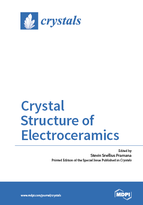Crystal Structure of Electroceramics
A special issue of Crystals (ISSN 2073-4352). This special issue belongs to the section "Inorganic Crystalline Materials".
Deadline for manuscript submissions: closed (30 April 2017) | Viewed by 67923
Special Issue Editor
Interests: crystallography; structure refinement; ionic conductor
Special Issues, Collections and Topics in MDPI journals
Special Issue Information
Dear Colleagues,
Electrical, optical, ionic and magnetic properties of ceramics are primarily dictated by their crystal structure. They can be improved by introducing impurities, creating long range order/short range order/disorder, engineering defects and utilising specific crystal anisotropy and orientation. This Special Issue is aimed at manuscripts focusing on the recent development of electroceramics and its relation to the crystallography, including the characterisation aspect. Scientists working in this area are invited to contribute.
In particular, the topic of interest covers but is not limited to:
• advanced structural characterisation techniques
• crystal structure determination, refinement and modelling
• structure at non ambient condition
• bonding in crystals
• 3D and 3D+n modulated crystallography
• crystallisation in Electroceramics
with an emphasis of the application towards, but not strictly limited to:
• ionic and electronic conductors
• dielectric
• ferroelectric
• magnetocaloric
• superconductors
Dr. Stevin Snellius Pramana
Guest Editor
Manuscript Submission Information
Manuscripts should be submitted online at www.mdpi.com by registering and logging in to this website. Once you are registered, click here to go to the submission form. Manuscripts can be submitted until the deadline. All submissions that pass pre-check are peer-reviewed. Accepted papers will be published continuously in the journal (as soon as accepted) and will be listed together on the special issue website. Research articles, review articles as well as short communications are invited. For planned papers, a title and short abstract (about 100 words) can be sent to the Editorial Office for announcement on this website.
Submitted manuscripts should not have been published previously, nor be under consideration for publication elsewhere (except conference proceedings papers). All manuscripts are thoroughly refereed through a single-blind peer-review process. A guide for authors and other relevant information for submission of manuscripts is available on the Instructions for Authors page. Crystals is an international peer-reviewed open access monthly journal published by MDPI.
Please visit the Instructions for Authors page before submitting a manuscript. The Article Processing Charge (APC) for publication in this open access journal is 2600 CHF (Swiss Francs). Submitted papers should be well formatted and use good English. Authors may use MDPI's English editing service prior to publication or during author revisions.






